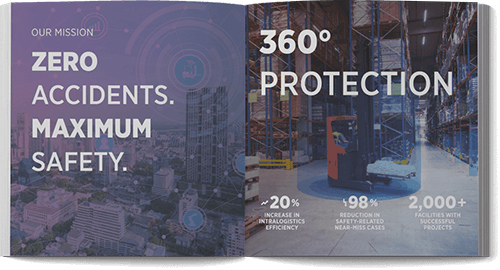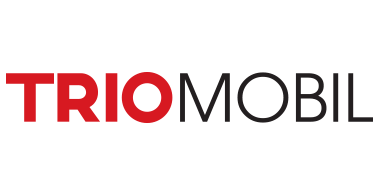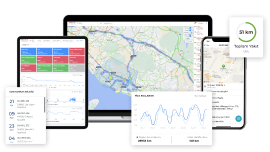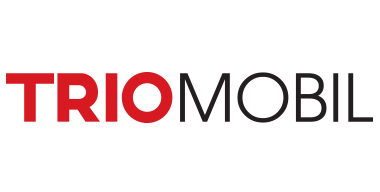Forklifts are a crucial tool for moving goods in warehouses, factory floors, and construction sites.
They make the loading and unloading of trucks and movement of goods and pallets manageable. Their maneuverability allows them to negotiate
warehouse and job sites effectively to transport items to where they’re needed. Like any piece of industrial equipment or machinery, however,
forklifts can be dangerous if proper safety precautions are not followed.
In the most recent reporting period, the National Safety Council (NSC) reported that there were
78 work-related deaths involving forklifts in 2020 and 7,290 accidents that required workers to take days off to recover. In some years,
deaths can reach as high as 100 and nonfatal accidents can exceed 20,000 incidents. When nonfatal forklift accidents occur, the median number
of days workers are away from work is 17 days.
Besides worker safety, the NSC also reports that the average cost of a forklift incident is $38,000 in direct
costs and as much as $150,000 in indirect costs. Fatal accidents or incidents where safety procedures weren’t followed can lead to even bigger
costs, including fines and lawsuits. However, even a single incident can be costly for organizations.
These are startling numbers, especially when you realize that an overwhelming majority of accidents
and deaths involving forklifts are preventable with the right training, maintenance, and technology.
What Type of Forklift Accidents Are Most Common?
Here are the most common forklift accidents that lead to fatalities:
- Forklift overturns
- Workers struck by forklift/Pedestrian accidents
- Workers crushed by forklifts
- Falls from forklifts
While these are the most serious forklift accidents that occur, other types of accidents occur as well, including:
- Forklift collisions
- Falling loads
- Forklifts falling off docks or trailers
- Mechanical failures
How Do Forklift Accidents Occur?
Lift trucks can weigh more than 9,000 pounds and travel up to 18 mph, which makes them dangerous machines if not used properly.
Since forklifts only have front brakes and often carry heavy loads, they can’t stop instantly even at normal
operating speeds. When turning, forklifts use their rear wheels and cause the back of the vehicle to swing outward. Improper operation can lead to tipping,
especially if operators are traveling too fast while turning.
Since loads are carried at the front of the forklift, this can also impact sightlines for the driver.
All of these things can make operating forklifts a safety concern even when operated properly.
Operators need to be cautious and diligent about safe operation since the biggest cause of forklift accidents is human error.
Drivers should never speed, travel with a raised load, or give rides to others. They need to constantly be
aware of their surroundings, especially in areas where there are other workers to avoid pedestrian forklift safety incidents.
How Can You Avoid Forklift Accidents?
Following the proper training, safety protocols, and maintenance — as well as adding in
safety tech and alarms—can significantly improve forklift safety in warehouse and construction use.
Training
All operators should be fully trained in OSHA and company procedures for the safe use of forklift equipment. There are specific training requirements for:
- Forklift operation
- Loading and unloading
- Seat belt and safety harnesses
- Overhead protective structures
- Alarms
- Maintenance
If operators are seen operating in an unsafe manner, involved in an accident or near-miss,
or assigned to a different type of forklift, they should also undergo refresher training.
Safety Protocols
Forklift safety requires workers not only to undergo training but to put that training into practice every day. OSHA requirements for safe operation include:
- Speeds should be limited so that forklifts can be stopped within safe distances.
- Operators must slow down and sound horns at cross aisles or any location where vision may be obscured.
- Operations must look forward and keep a clear view of travel paths.
- Loads should only be lifted as high as needed to clear surfaces.
- Loads should be tilted back to help prevent shifting.
- Forks should not be raised or lowered during movement.
- No unauthorized riders should be permitted.
- Forklifts should not be driven to locations where pedestrians or workers are standing in front of unmovable objects.
Daily Inspections & Maintenance
OSHA requires all forklifts to be evaluated before being placed in service daily. Forklifts should be inspected at the beginning
and end of each shift, which can mean multiple daily inspections for 24-hour operations. Defects need to be reported and corrected before operations.
OSHA provides a sample checklist for forklifts, including what operators should do during key-on and key-off inspections for safe operation.
IoT Solutions to Reduce Forklift Accidents
Since so many accidents occur because of human error, adding technological solutions to your forklifts and
warehouses is crucial to maintaining safe operations. IoT solutions provide high-precision tracking of equipment and workers to avoid dangerous interactions.
Organizations can use IoT solutions to improve safety and reduce accidents by implementing tech to reduce the risk for:
- Forklift to forklift accidents using collision avoidance systems
- Forklift to pedestrian accidents using accident prevention systems
- High-risk area using zone-based controls
- Other safety measures
Forklift Collision Avoidance System
A forklift collision avoidance system can detect moving equipment such as forklift trucks using Ultra Wide Band (UWB)
technology. No internet or cell signals are required. When a forklift comes into range of another forklift or moving machinery, audible and visual signals
let the lift truck operator know there are other trucks nearby.
The system can also automatically reduce speeds. Users can configure systems based on their safety requirements and zones.
Forklift Pedestrian Collision Avoidance System
Forklift pedestrian collision avoidance system detects pedestrians as well. Wearable tags stay in constant communication
with the system, also using UWB. When pedestrians and forklifts are closer than the distance you choose, the system alerts operators and pedestrians and
limits forklift speeds automatically.
Forklift operators receive a visual and audible signal letting them know pedestrians are nearby, even when they are in blind
spots or around corners. The wearable tags provide a vibration warning to pedestrians, which increases in intensity the closer they are to forklifts. This works
especially well in a noisy environment or for workers that may have hearing issues.
Zones can be defined and configured based on company policies. There are several types of wearable tags, including badge holders, lanyards, and watch bands.
Zone-Based Forklift Speed Control
Zone-based controls can also be deployed for areas, including areas that have a higher risk of accidents, such as narrow corridors,
interactions, or high pedestrian activity. Fixed anchors in zones can be configured that signal forklift and adjust speeds automatically.
Other Safety Measures
IoT devices can also be used for custom solutions, such as automating the opening of dock doors
when a forklift approaches or preventing access to unsafe or restricted areas.
Using IoT solutions and UWB also provides additional benefits. The same infrastructure can be used for
indoor tracking of all assets in real-time. This can help you see at a glance where every piece of equipment is and help optimize workflow.
Wearable can also help you keep track of employees, including monitoring how much time workers spend
in particular areas, tracking work and rest times, and managing access.
Reducing Forklift Accidents
To learn more about the benefits of IoT in reducing forklift accidents, request a demo today from the experts at Trio Mobil.








